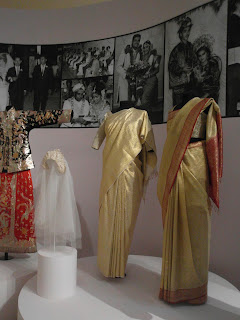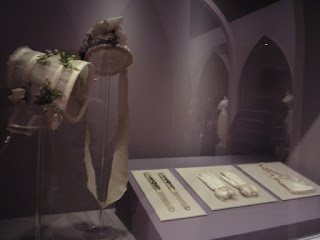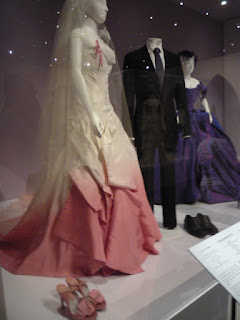After the long wait of a week, here is the much anticipated (or maybe not), post about the special exhibition: The Wedding Dress.
It was a lovely experience and I enjoyed every bit of it.
Visit while you still can!!!
I've inserted a description of these beauty (as it is segregated according to different section), now let it begin...
Free for preview, these pieces are displayed outside the entrance.
It features wedding attires of the various ethnic group in Singapore!
---------------------------------------------------------------------------------------------
A White Wedding
"From 1700 to 1790, the color of wedding dresses was used to show how socio-economic status of the bridge & bridgegroom and their families."
Higher status - silver & white.
Lower status - Avoid wearing white due to the financial inability to maintain the cleanliness of the white fabrics.
"Queen Victoria wore a white wedding dress in 1840, the trend surged in popularity among the young and wealthy women who were marrying for the first time. Although other colors and pattern skills were introduced, the use of color white has stood the test of time, and it has become the quintessential color for weddings...due to association with attributes such as innocence and purity"
The Victorian Bridegroom (1837 - 1901)
Waistcoats
"Waistcoats were one of the popular garments worn by bridegrooms. Silver thread was sewn onto waistcoats because the color silver means purity...and upper class. The waistcoat, also known as a vest, is a sleeveless upper-body garment worn over a shirt and under a coat as part of a formal outfit. It was originally worn by men but was subsequently adopted by women after the French Revolution in 1789 and became a popular piece of everyday clothing throughout the ages."
The Victorian Bride (1837 - 1901)
A Bride's Accessories.
"During the reign of Queen Victoria from 1837 to 1901, the white wedding dress, orange-blossom wreath and veil became traditional rather than being just a fashion statement"
"One of the most classic symbols of a wedding is flowers. Traditionally, flowers hold significant meanings and were used in weddings for this purpose. Up till today, flowers are still used for different occasions based on the meanings they represent. For instance, sunflowers are given to friends as thank you gesture while lilies are used in burials as a symbolism of life."
Artistic Style (1900 - 1930)
Wedding Trends and Social Customs
"After the end of WW1 in 1918, social customs became more relaxed as women entered the workforce and became increasingly fashion-conscious. While day wear still featured hues of white and cream, pastel and metallic tones gained popularity. The trend of wearing evening wear also became more distinct as the choice of fabric, type of cut and decoration provided options for people to wear the wedding dress in various colors other than white and cream, which remained popular nonetheless."
The Society Wedding (1920 - 1930)
The Rich and Famous
This gown above with the longest train in this exhibition is 3.6 meters in length and was worn by a socialite, Margaret Whigham. She wore the the immaculate Hertnell-designed wedding gown when she married Charles Sweeny in 1933.
From Austerity to the 'New Look' (1939 - 1951)
Fashion on a budget
During WW2, textiles were rationed due to their high costs. As a result, women became more focused on meeting their their family's basic clothing needs and were frugal. (......)
Innovation to Individuality (1950s - 1970s)
Expression of Individuality through Fashion
(......)
That concludes me after viewing the museum! (:
p.s: pardon the quality of pictures, there are reflections of the crowd and thus may not be that clear.
all sources from nmsg and the educational guide obtained during the visit.

















































No comments:
Post a Comment